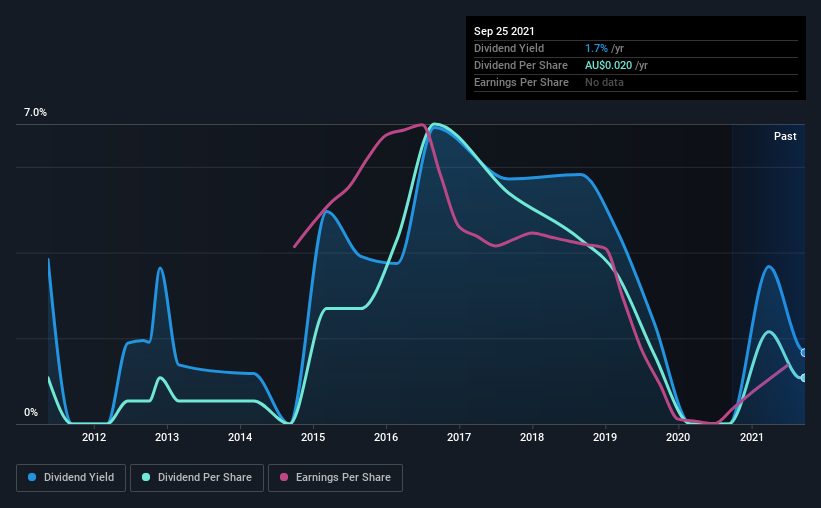Do These 3 Checks Before Buying CI Resources Limited (ASX:CII) For Its Upcoming Dividend
Some investors rely on dividends for growing their wealth, and if you're one of those dividend sleuths, you might be intrigued to know that CI Resources Limited (ASX:CII) is about to go ex-dividend in just four days. The ex-dividend date is one business day before the record date, which is the cut-off date for shareholders to be present on the company's books to be eligible for a dividend payment. The ex-dividend date is an important date to be aware of as any purchase of the stock made on or after this date might mean a late settlement that doesn't show on the record date. Meaning, you will need to purchase CI Resources' shares before the 30th of September to receive the dividend, which will be paid on the 29th of October.
The company's next dividend payment will be AU$0.01 per share. Last year, in total, the company distributed AU$0.02 to shareholders. Calculating the last year's worth of payments shows that CI Resources has a trailing yield of 1.7% on the current share price of A$1.2. If you buy this business for its dividend, you should have an idea of whether CI Resources's dividend is reliable and sustainable. As a result, readers should always check whether CI Resources has been able to grow its dividends, or if the dividend might be cut.
Check out our latest analysis for CI Resources
If a company pays out more in dividends than it earned, then the dividend might become unsustainable - hardly an ideal situation. CI Resources paid out more than half (51%) of its earnings last year, which is a regular payout ratio for most companies. A useful secondary check can be to evaluate whether CI Resources generated enough free cash flow to afford its dividend. It paid out an unsustainably high 255% of its free cash flow as dividends over the past 12 months, which is worrying. It's pretty hard to pay out more than you earn, so we wonder how CI Resources intends to continue funding this dividend, or if it could be forced to cut the payment.
CI Resources does have a large net cash position on the balance sheet, which could fund large dividends for a time, if the company so chose. Still, smart investors know that it is better to assess dividends relative to the cash and profit generated by the business. Paying dividends out of cash on the balance sheet is not long-term sustainable.
CI Resources paid out less in dividends than it reported in profits, but unfortunately it didn't generate enough cash to cover the dividend. Cash is king, as they say, and were CI Resources to repeatedly pay dividends that aren't well covered by cashflow, we would consider this a warning sign.
Click here to see how much of its profit CI Resources paid out over the last 12 months.
Have Earnings And Dividends Been Growing?
Companies with falling earnings are riskier for dividend shareholders. If business enters a downturn and the dividend is cut, the company could see its value fall precipitously. CI Resources's earnings per share have fallen at approximately 28% a year over the previous five years. Ultimately, when earnings per share decline, the size of the pie from which dividends can be paid, shrinks.
Another key way to measure a company's dividend prospects is by measuring its historical rate of dividend growth. CI Resources's dividend payments are broadly unchanged compared to where they were 10 years ago. When earnings are declining yet the dividends are flat, typically the company is either paying out a higher portion of its earnings, or paying out of cash or debt on the balance sheet, neither of which is ideal.
The Bottom Line
From a dividend perspective, should investors buy or avoid CI Resources? CI Resources had an average payout ratio, but its free cash flow was lower and earnings per share have been declining. It's not that we think CI Resources is a bad company, but these characteristics don't generally lead to outstanding dividend performance.
So if you're still interested in CI Resources despite it's poor dividend qualities, you should be well informed on some of the risks facing this stock. Our analysis shows 1 warning sign for CI Resources and you should be aware of it before buying any shares.
A common investment mistake is buying the first interesting stock you see. Here you can find a list of promising dividend stocks with a greater than 2% yield and an upcoming dividend.
This article by Simply Wall St is general in nature. We provide commentary based on historical data and analyst forecasts only using an unbiased methodology and our articles are not intended to be financial advice. It does not constitute a recommendation to buy or sell any stock, and does not take account of your objectives, or your financial situation. We aim to bring you long-term focused analysis driven by fundamental data. Note that our analysis may not factor in the latest price-sensitive company announcements or qualitative material. Simply Wall St has no position in any stocks mentioned.
Have feedback on this article? Concerned about the content? Get in touch with us directly. Alternatively, email editorial-team (at) simplywallst.com.

 Yahoo Finance
Yahoo Finance 
